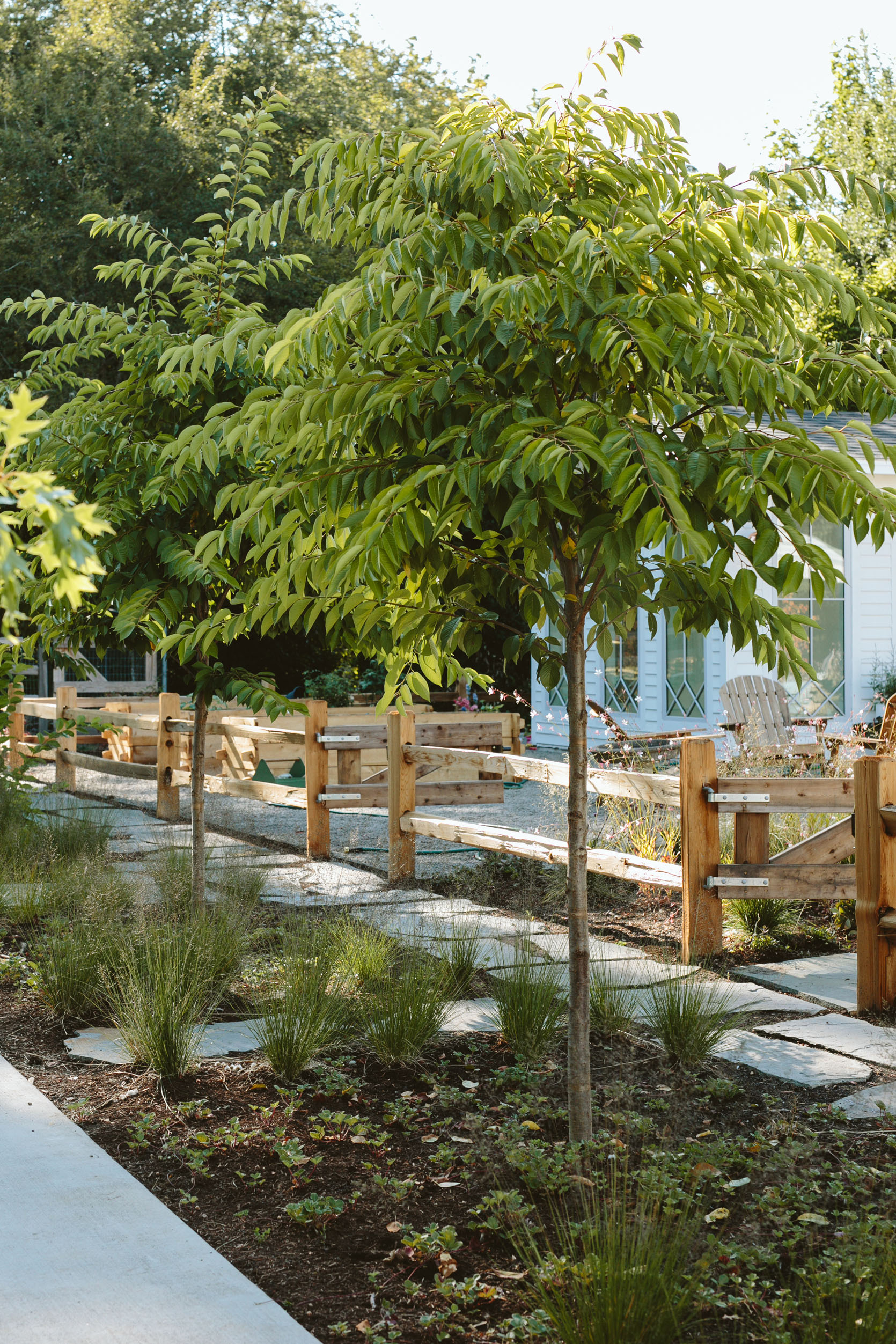Ya’ll, once again I was lucky enough to learn so much from professionals and experts – this time about landscaping. This job was massive and while a lot will thrive in Oregon (due to rain), I wanted someone who understood the vibe we were going for and I could trust to stay in line with that goal. When we met with Cali Pfaff from Studio Campo and she just got us – she has a very sophisticated and yet really casual approach to landscape design that felt so right to us. Our tastes were totally aligned which felt so good. Every presentation she showed us was so beautiful, and we had so little feedback because she just nailed it. So today she is going to share some of her expertise with y’all – it’s such an informative post. Thank you, Cali!
Hi there, my name is Cali and I run a landscape architecture practice, Studio Campo, with a focus on naturalistic design. Over the past two years, I have worked with Em and Brian to develop a farm master plan and am excited to share with you all some of the thinking behind the garden and tips for how to achieve a similar look at home. Throughout the process, we have had a number of amazing collaborators whose hearts and minds informed the design, including Yardzen, Northwest Native Landscapes, and ARCIFORM. Most critically, I want to thank Emily and Brian for trusting me with their garden. We will begin with a little garden psychology on how to craft a mood, provide some tips on assessing your site, and then dive into how we developed the plant palette at Em’s house and how to achieve a similar look in your home. I am happy to address any questions you may have in the comments.
Before we begin, you may be wondering what is a natural garden exactly? And what makes a plant native? In essence, a natural garden mimics the function and appearance of nature; it is designed with ecology in mind. For some of you, it may feel messy and it is, in certain ways. What we sought to do in their yard is balance naturalistic planting with moments of quiet (the lawn, the patio, the pool) and use a curated color palette to give a sense of cohesion and warmth. As for native plants, I find it helpful to think about the larger ecosystems that shape your location, rather than strictly going by what plants fall within state lines. Portland, for example, abuts the coastal mountains and the Pacific Coast temperate rainforest and resides along the Willamette River and its fertile inland valleys. For Em’s garden, we drew from both of those landscapes and used a mix of native and adaptive (non-native, non-invasive, climatically appropriate) plants; it is a both-and situation.
Crafting A Mood

Gardens are deeply personal spaces. Done right, they can invoke memories and connect us to a wilder world. When starting a garden design project, I ask clients a few framing questions to better understand what they find beautiful (and not beautiful), and how their garden can help them live the life they imagine for themselves.
- What kind of landscape did you grow up in?
- What are your strongest memories of gardens and/or the outdoors?
- What does a perfect morning at home look like to you?
Often, people’s sense of beauty is rooted in the place they grew up or a “chosen home” they settled on later in life. When working with Emily and Brian, their answers to this first question were telling and shaped the layout of the garden as a whole. Brian had vivid memories of playing sports on a big grassy lawn as night set in. Emily’s childhood was a bit more woody, snacking on huckleberries in the woods with her siblings. So we knew we needed both pieces: the structure and formality of the lawn with loose, naturalistic planting and wild edges. Brian and Em also put a lot of thought into the type of childhood the farm would create for their kids and the overall farm plan was developed with a sense of adventure in mind. The combination creates a landscape that is very them and strikes a delicate balance between manicured and natural.





When designing a natural garden for yourself, one way to begin is to think on what kind of mood or feeling you are after. Moody, joyful, quiet, lush? Does your current garden capture this feeling? What feels inharmonious? There are many factors (program, budget, maintenance, climate, etc.) that impact a garden’s design but mood is often overlooked and can be a helpful bellwether for the design. For the Hendersons, key descriptors were natural, unfussy, and farmy, with an ongoing conversation on how to balance simplicity with a sense of abundance.
- Garden Mood-Setting Tips:
- Create a mood board to capture the feeling of your garden (example above), then divide it out into spaces or elements you’d like to incorporate into the garden as a whole.
- Map out how you spend a typical day off at home and see if there are any tweaks to your routine that would prompt you or your family to spend more time outdoors (e.g. a shaded dining table, a great reading chair, an outdoor movie screen, a remote office space, etc). Design is habit forming, try putting a super comfy chair outdoors and see if it shifts your routine.
- Look out of every window in your house. What do you see? What do you want to see? Varying the foreground, middle ground, and background will make the garden more dynamic and allow for privacy from certain rooms, longer views from others.
- Journal on the framing questions above, ask a garden-curious friend to do the same, and discuss your answers over coffee.
Understanding Your Site (And Yourself)

The more you know about your property and its local ecology, the better equipped you will be to design with nature. My suggestion to anyone starting a garden project is to map what’s existing and then test your soil. There is a tendency to add compost to any and all soil. This can be a mistake, particularly when working with native plants. Many native species (prairie plants in particular) thrive in nutrient-poor soil where there is less competition and deep root systems allow the plants to weather droughts. When we over-enrich the soil, we provide ideal conditions for weeds to thrive. For a natural garden, irrigation should ideally focus on allowing healthy plants to establish and weather extreme temperatures, rather than acting as continual life support.

Ultimately, your garden will be happier if you match your plant palette to the local climate (precipitation, sun, winter hardiness) and to your property (soil type, drainage, proximity to buildings and infrastructure, etc.). I know that this may seem a little heartbreaking if your taste is at odds with the norm in your area but you can truly create any style of garden using native and adaptive plants; it’s all about how you combine them, something we will cover in a bit.

Lastly, be honest with yourself on maintenance. Not everyone enjoys gardening and fewer love weeding. There is no shame in starting small with a single bed or a few pots to test out ideas. If you are committed to a more natural garden but are not crazy about maintenance, try replacing aging trees and shrubs with native species that can provide a broad range of ecological services (nesting grounds, winter forage, high-nutrient food) with little additional maintenance. Em and Brian made a maintenance-driven decision at their place to narrow the beds around their house and limit higher maintenance planting to those zones.
- Site Assessment Tips:
- Consider a 6-month moratorium on landscaping when you move into a new place. Keep notes of areas that are thriving and those that need help before planning a renovation or engaging a designer.
- Test your soil! The more you can align your plant selection to your soil, the happier your plants will be. Most states have an agricultural school where you can send in samples or there are at-home kits available at Home Depot or garden centers. What you are looking for is info on soil type (sandy, loamy, clayey), soil richness or fertility, and nutrient deficiencies or excesses (nitrogen, potassium, etc.).
- Walk your neighborhood. You can get a ton of inspiration and granular data on what plants thrive in your area by going on a long walk. iPhoto has a great feature where you can identify plants by clicking the info icon at the bottom of your photo.
- If you live in an arid region, look up dry gardens and gravel gardens for ideas on how to pull off low water and lush. You can also search these terms alongside a garden style you are fond of (“cottage style dry garden”) to see what’s possible.
Honing Your Color Palette

Not all landscape designers use color to structure planting but I find a dialed-in color palette can provide a sense of cohesion and helps to narrow the plant list. Luckily for this project, Em is a magician with color. The exterior paint selection for the residence ultimately settled on a palette heavy on white with dusty blue, copper, and black accents. Tonally, Em had a vision for the garden from the start, with shades of blush, white, copper, and burgundy. Something soft, layered, and rooted in the landscapes of the Pacific Northwest. To balance the pinks and warm tones, we used accents of black, burgundy, and sage in the planting to give depth and interest to the planting beds. We used a triadic color palette (sage, copper, burgundy). The planting around the house is lush, diverse, and hedges on the wilder side. The constrained color palette and tidy lawn create a nice contrast to the lushness of the planting and act as visual cues to visitors that the overgrown feeling is intentional.

- Garden Color Palette Tips:
- If you have a color in mind, search for abstract paintings of the color online to explore interesting color combinations. Abstract expressionists like Joan Mitchell, Mark Rothko, and Clifford Still are favorites of mine.
- If you already have your exterior paint palette selected, use a color palette tool (Coolors, Adobe, and Canva all have free options) to test out complementary, monochromatic, triadic, and analogous combinations for your plant palette.
- Visit a favorite regional open space and take photos with color top of mind. What are the color overtones? What tonality are the rocks and soil? What plants set the palette? This can change seasonally too.
Curating A Natural Plant Palette

The Hendersons’ planting divides into three palettes: full sun, part shade, and native/unirrigated for the outer edges of the property. The idea is that the planting is more curated close to the house and gets softer and more natural as you move away. The full sun and part shade palettes align with the houses’s solar orientation and creates a nice alternating rhythm as you circle the house. The Henderson’s front door faces north and the part shade palette is more subdued, borrowing from the native coastal woodlands Em grew up in. As you move towards to back deck—facing West, the planting gets more wild, colorful, and is heavier on perennials, which provides a nice sense of movement and whimsy. The full sun palette is prairie-inspired and draws from a wider range of plants.


The plant palette should build interest across seasons, provide enough structure for the dormant season, and have a range of blooms, forage, and habitat for wildlife. There are a number of great resources that I will include at the end of this article on naturalistic planting but here are some key design ideas: the first is that naturalistic planting is built in layers. The ground cover underlays a dynamic mix of perennials and grasses, seasonal bulbs pop up through, and shrubs and trees add structure, shade, and winter interest. Planting is dense and dynamic, as you would see in the wild. We planted Emily’s garden in May and the beds are beginning to take off. It will take another 2-3 years before they really hit their stride. While I promote density in grasses, ground cover, and perennials, it is important to provide trees and shrubs ample space to reach their mature size. You can underplant shrubs with other plants but leave enough space between shrubs and trees for them to stretch out.



Next, let’s talk bloom cycles. If you are musically inclined, the bloom cycle is like an orchestral arrangement of flowers colliding across the seasons. Ecologically speaking, the longer and more diverse the bloom, the more wildlife your garden can support. It is truly win-win. One mistake I often see in DIY garden design is that people go to the garden center, buy whatever is beautiful and in bloom, and end up with garden that only blooms for a short window. Here are some combinations to try at home that will span the seasons:

Full Sun
Echinacea, Ornamental Grass, Penstemon, Sedum, Ninebark
All these plants are common in nurseries and come in a vast array of colors, textures, and sizes. In the first row are the species used in Emily’s garden, followed by two variations to show the versatility of these plants.

- Natural Plant Palette Tips:
- Skip the mulch. I know this may sound crazy but mulch is not necessary in all situations. Densely plant your perennials, grasses, and ground covers. As plantsmen Thomas Rainier says, the plants are the mulch.
- Double down. As your garden matures, double down on the plants that are thriving. You can do this by collecting seed, taking cuttings, or heading to the nursery. Repetition shows intentionality in the planting and if a plant makes you smile, grow more.
- Demand better. The nursery industry still has a lot of catching up to do when it comes to growing and supplying native plants. If your nursery or local Home Depot doesn’t have what you are looking for, ask them to order it. Consumers have the power to move the market.
- Explore nativars. Native plants are wild by nature, they spread, breed, and drop fruit. These are all beautiful things but not always next to your foundation and in a narrow bed. Nativars are nursery adaptations of native plants, some are bred for size, interesting color combinations, or sterility. They can often provide many of the same ecological services without the issues of a full-fledged native plant. Some we used at the Henderson’s are: “Tiny Wine” Ninebark, “Lynnhaven Carpet” Robin’s Plantain, and “Peewee” Oakleaf Hydrangea.
And with that, we close! Thank you for reading and if this piqued your interest, below are some resources you may find helpful as you plan your own garden. For those doubly curious about Em’s garden, we have included the full plant palette on our website.
Natural Gardening Resources
Planting the Natural Garden by Piet Oudolf and Henk Gerritsen
- Natural gardening classic with images and recommendations on the favorite plants by the most well known plantsman in the world
New Naturalism: Designing and Planting a Resilient, Ecologically Vibrant Home Garden by Kelly Norris
- I love this book. Beautifully written and touches on geology, ecology, and other forces shaping your garden, all while being accessible to the reader. Gah photos and plant guides.
Prairie Up: An Introduction to Natural Garden by Benjamin Vogt
- User-friendly guide on how to transition your yard into a habitat area and not scare your neighbors. Best step-by-step book on the process of natural garden-making.
Planting in a Post-Wild World: Designing Plant Communities for Resilient Landscapes by Thomas Rainer
- This is the most technical of the recommendations but SO GOOD. Introduced new thinking into planting design on how to bring nature into built landscapes. Great diagrams.
*Photos by Kaitlin Green
THIS POST WAS ORIGINALLY PUBLISHED HERE.


